Setsubun Extra
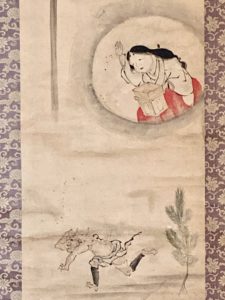
Setsu-bun, 節分, Season-divide, is celebrated on February 3, the eve of Ri-sshun, 立春, Start-spring. Actually, there are Setsubun on the eves of each of the four seasons, but that of spring is the most popular. According to tradition, a man born in that particular year, toshi-otoko, 歳男, year-man, wears a mask of O-ta-fuku, お多福, O-much-fortune, and throws parched soy beans, fuku-mame, 福豆, fortune-beans, from an open box, fuku-masu, 福升, fortune-measure, to chase away the harshness of winter. The harshness of winter is embodied in the figure of an oni, 鬼, demon. The toshi-otoko shouts, “Oni wa soto fuku wa uchi”, 鬼は外福は内, Demon is out fortune is in. Throwing the beans at the oni is called mame-maki, 豆撒, bean-scatter.
Sen Sō-tan, 千宗旦, Thousand Sect-dawn, scattered beans from the nijiri-guchi, 躙口, crawl in-opening, of his Tea hut, Yū-in, 又隠, Again-retire, to locate the tobi-ishi, 飛び石, flying-stones, in the ro-ji, 露地, dew-ground, garden. They are called the ‘Mame-maki Ishi’, 豆撒石, Bean-scatter stones. Sōtan was born on New Year’s day: Ten-shō 6 Nen 1 Gatsu 1 Nichi, 天正6年1月1日, (1578, 2, 7).
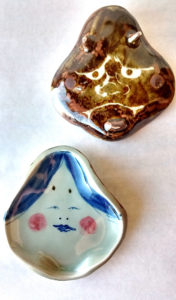
Two porcelain plates showing front and back: colorful design of the face of O-ta-fuku, お多福, O-much-fortune, and the face of an oni, 鬼, demon, the horns and chin giving stability; approximately 5 x 5 sun kane-jaku, made by An-dō Takumi, 安藤工, Peace-wisteria Worker, Kyōto, Tajima, Gifu. Suggested design by Palmer for souvenirs at a Setsu-bun cha-kai, 節分茶会, Season-divide Tea-gathering, in Kyōto in the 1980s.
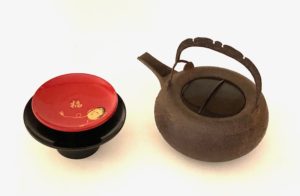
Sake served at a Cha-ji, 茶事, Tea-matter, is warmed, not chilled, and not boiled. The shallow sake cup is held with both hands, and the server pours sake. The server is in a higher position, such as a Shintō priest pouring O-mi-ki, お神酒, Hon.-god-sake.
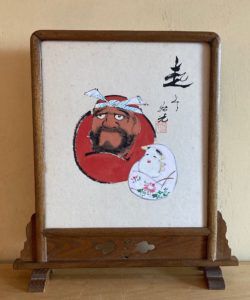

The diameters of the two rounds of mochi may have a remarkable association. The diameter of the larger round is 3.25 sun kane-jaku or 2.6 sun kujira-jaku, the diameter of the smaller round is 2.5 sun kane-jaku. The height of just the double mochi is 2.5 sun kane-jaku, which is the same as the diameter of the smaller round. For more on mochi, see also Mochi Pounding for the New Year.
The ratio between the two diameters is very nearly 8:10. After millions of such pieces have been molded and manufactured over the years, it may be that, originally, the diameter ratio was 8:10. The numbers 8 and 10 are symbolic of Infinity in Space, and ya-ta, 八咫a, eight-span (10), as with the Ya-ta Kagami, 八咫鏡, Eight-span Mirror, the sacred Shintō symbol of Ama-terasu, 天照, Heaven-brighten, the sun goddess.
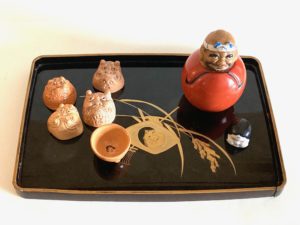
Sake may be served whenever one wishes, and in a Cha-ji, 茶事, Tea-matter, additional sake may be offered separately with an azuke dokkuri, 預け徳利, leave virtue-advantage, that is left with the guests to serve themselves. The kannabe requires a server, which is the higher position, whereas, with a sake bottle, one can serve oneself. The sake cups may be a variety of forms and materials and sizes.
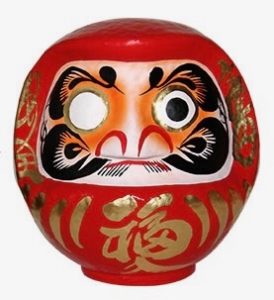
Daruma nin–gyō, 人形, person-shape. The doll, without eyes, is made in various sizes from tiny to enormous. With a goal in mind, one of the eyes is painted in, and when the goal is achieved the other eye is painted, with gratitude. The doll may be taken to the temple where it was purchased to that it can be burned in a sacred fire on the day of Setsu–bun, 節分, Season-divide.
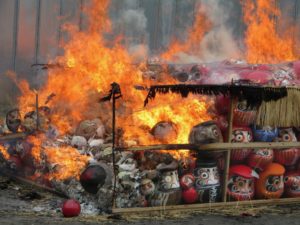
Daru-ma Ku-yō, 達磨供養, Attain-polish Offer-nurture, memorial, is an annual event held on Setsu-bun, 節分, Season-divide, when Daruma dolls are burned at Buddhist temples, in thanks for blessings. Extinguishing the Daruma dolls may be likened with the Nirvana and the cremation of the Buddha. Also, there is a deep connection between Otafuku and another of her companions, Hyo-ttoko, 火男, Fire-man. He may have had his origins in Saru-ta Hiko, 猿田彦, Monkey-field Lord.
A pair of hashi-oki, 箸置, chopstick-place, porcelain ‘masks’ of Hyo-ttoko, 火男, Fire-man, and O-ta-fuku, お多福, O-much-fortune, with a pair of sugi-bashi, 杉箸, cedar-chopsticks. Hyottoko is another of Otafuku’s companions. His puckered mouth is due to blowing into a bamboo tube to fuel a fire. This activity happens at a Cha-ji, 茶事, Tea-matter, in which rice is cooked over the fire in the hearth, and the guests take turns blowing into the bamboo pipe.
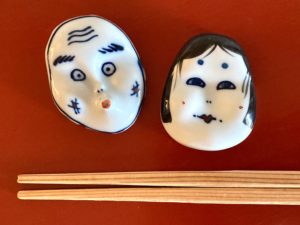

Tan-zaku, 短冊, short-volume, long narrow paste with painted color picture of masks of O-ta-fuku, お多福, O-much-fortune, and Saru-ta-hiko, 猿田彦, Monkey-ricefield-lad, shin-en-rei, 神苑例鈴, god-garden-bells, with long trailing five-color ribbons: signed, Waka-miya Shi-ka, 若宮紫香, Stone-palace (young imperial prince) Purple-fragrance; L. 9.5 x 1.5 sun kujira-jaku.
Saruta Hiko is the ancestor of the Ten-gu, 天狗, Heaven-dog, warrior-like Buddhists known for their tutorial skills in the mountains. They are also identified with fire, and being immune to its destructive nature.
O-ta-fuku, お多福, O-much-fortune, is depicted with various male companions, such as the long-nosed, red-faced Saru-ta-hiko, 猿田彦, Monkey-ricefield-lad, pictured in the tanzaku. He was the guardian of the eight crossroads, who succumbed to the charms of Ame-no-uzu-me no Mikoto, 天之鈿女命, Heaven’s-ornament-woman Lady, who later is identified with Otafuku.
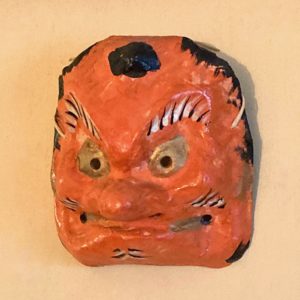
The gold eyes indicate that he is a deity. The Saga masks have been made for over 600 years, but the tradition was lost after the Second World War, and revived by Fujiwara Toshiyuki. The above mask by Toshiyuki San was acquired in the 1970s, and his son continues creating the masks.
In February, Valentine’s Day is celebrated on the 14th, named for Valentine, a Roman Christian, who was beheaded in 270 A.D. by a decree from Claudius II, for defying marriage bans. The romantic connections with Valentine began in the 15th – 16th century.

The unofficial holiday has been widely enjoyed for years in Japan. Otafuku and her companions have been images of shared affection throughout the country. In the early 20th century, a box of chocolates was given by a young woman to her boss. Observances have grown. The valentine heart-shape design, kokoro, 心, heart, that theoretically resembles the human organ, shin-zō,
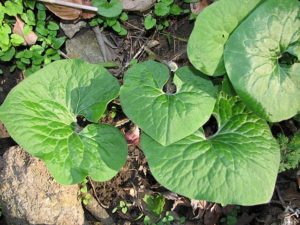
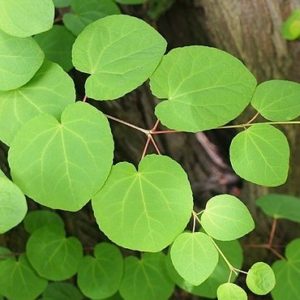
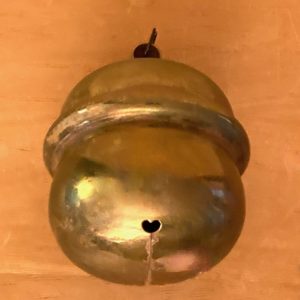
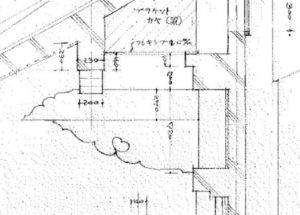
From left: aoi, 葵, wild ginger, ground plant leaves. Katsura, 桂, cinnamon bark tree, leaves. Brass shrine suzu, 鈴, bell. Japanese architectural design with small ‘heart’-shaped aperture.
In Japan, the heart-shape, kokoro, 心, heart, is present in the leaves of certain plants. The heart-shaped leaves of the aoi, 葵, wild ginger, have been a sacred symbol of procreation at the ancient festivals of Kami-ga-mo Jin-ja, 上賀茂神社, Upper-joy-abundant God-shrine. The same is true of the katsura, 桂, cinnamon tree, which is a replacement for aoi leaves. There is a heart-shape aperture at the end of the slit of a suzu, 鈴, bell. Japanese architecture bracket, ude-gi, 腕木, arm-wood, and ki-bana, 木鼻, wood-nose, at times has a ‘heart’-shape opening that is part of a kumo, 雲, cloud, pattern, which has been used for centuries.
For more on Setsubun and Otafuku, see also: Setsubun and Otafuku (article), Setsubun and Risshun (article), Tea in February (article), Setsubun and Otafuku (picture gallery), Setsubun Lecture (video), Setsubun Tea Gathering (video).

